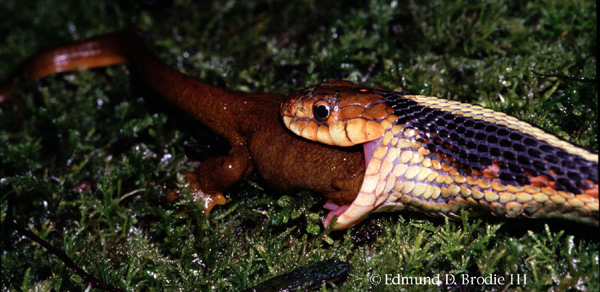Interactions
Adult Rough-skinned Newts feed
carnivorously mostly on soft-bellied, slow-moving prey and
aquatic invertebrates at night. A list of a few of the kinds and
types of creatures that adult newts prey on are as follows;
small tadpoles, amphibian eggs and larvae, other salamander eggs
and frog eggs, crustaceans, insects, arachnids, mollusks,
annelids, freshwater sponges, and occasionally small fish (Amphibiaweb
2013). Larval newts prey mostly on protozoans which are
scraped off of rocks and the occasional insect larvae or small
crustacean. Large larval newts have also been known to eat
smaller larval newts. Adults hunt their prey in a slow
determined fashion before quickly snapping at it and causing a
suction to pull and swallow the prey, larger prey are sometimes
grasped in its jaws (Amphibiaweb 2013).
Algae and plant matter have also been found in the stomachs of
newts although in small quantities thought to be accidentally
ingested with other foods (Amphibiaweb
2013).
Due to the Rough-skinned Newts high levels of tetrodotoxin it
has very few natural predators.
Thamnophis sirtalis, the
Common Garter Snake, has developed,
through coevolution, strong resistance to the effects of
tetrodotoxin therefore the newt can be eaten with little to no
side effects (Ridenhour et al. 2007).
This is known as a predator-prey arms race, where the prey
evolves higher concentrations of toxin and the predator evolves
higher resistance (Brodie III and
Brodie Jr. 1999). Over time this brings about species of
extremely high toxicity, many times more so than is necessary,
as one newt is toxic enough to kill an estimated 25,000 mice (California
Herps 2013). Levels of toxicity and toxicity resistance in
both species vary with geography, with some populations of newts
being less toxic and thus the Garter Snakes of that area being
less resistant to the tetrodotoxin (Ridenhour
et al. 2007). A picture of a newt being eaten by a
Gartner Snake, despite its high toxicity, can be seen on the
right side of the page. According to Gall et al. (2011), Rough-skinned
Newts
can pick up on chemosensory cues from common garter snakes and
other Rough-skinned Newts. These cues can let the newt know if
there was a newt that was injured near it or if there is a
garter snake that has eaten a newt nearby. The newt will avoid
the Garter Snakes that have previously successfully eaten a newt
but will not avoid Garter Snakes that haven’t eaten a newt or
other newts giving off cues of injury (Gall
et al. 2011). Other animals have been found to attempt to
eat Rough-skinned Newts but are usually found dead, such as
Bullfrogs and birds (Amphibiaweb 2013).
concentrations of toxin and the predator evolves
higher resistance (Brodie III and
Brodie Jr. 1999). Over time this brings about species of
extremely high toxicity, many times more so than is necessary,
as one newt is toxic enough to kill an estimated 25,000 mice (California
Herps 2013). Levels of toxicity and toxicity resistance in
both species vary with geography, with some populations of newts
being less toxic and thus the Garter Snakes of that area being
less resistant to the tetrodotoxin (Ridenhour
et al. 2007). A picture of a newt being eaten by a
Gartner Snake, despite its high toxicity, can be seen on the
right side of the page. According to Gall et al. (2011), Rough-skinned
Newts
can pick up on chemosensory cues from common garter snakes and
other Rough-skinned Newts. These cues can let the newt know if
there was a newt that was injured near it or if there is a
garter snake that has eaten a newt nearby. The newt will avoid
the Garter Snakes that have previously successfully eaten a newt
but will not avoid Garter Snakes that haven’t eaten a newt or
other newts giving off cues of injury (Gall
et al. 2011). Other animals have been found to attempt to
eat Rough-skinned Newts but are usually found dead, such as
Bullfrogs and birds (Amphibiaweb 2013).
Rough-skinned newts have been found coexisting with other
newt and salamander species such as Ambystoma gracile
the Northwestern Salamander, T. torosa- California Newt, and T.
rivularis the Red-bellied Rewt. Rough-skinned Newts tend to
exclude the California Newt from their habitat more than the
other species of newt (Amphibiaweb 2013).
When the rough-skinned newt shares a habitat with the
Northwestern Salamander the adult newt is smaller in size
compared to populations of newts that exist without the
salamanders (Amphibiaweb 2013).
This is probably because of competition for food, resources and
breeding grounds.
The Rough-skinned Newt is often sold as a pet under the name
“Oregon-newt” or “Orange-bellied Newt”. Calling it an
Oregon-newt, however geographically accurate, would not be an
accurate description because it is illegal to commercially
collect newts from Oregon for the pet trade, so one would likely
be getting a Rough-skinned Newt from California (Caudata
2002). They are not an endangered or threatened species and
the only conservation issue is deforestation of their breeding
grounds which doesn’t represent a huge impact (California
Herps 2013). The Rough-skinned Newt is safe to handle as
long as it is not ingested, although one should wash their hands
after handling the newt. There is some evidence that UV-B light
has a negative effect on the newt, but not a lot of research has
been done in that area (California
Herps 2013). Other animals that have tetrodotoxin in their
skin are the
Pufferfish and the
Blue-ringed Octopus as well as
other newts of the genus Taricha (TTX
2001). For more information on Tetrodotoxin see
Tetrodotoxin.